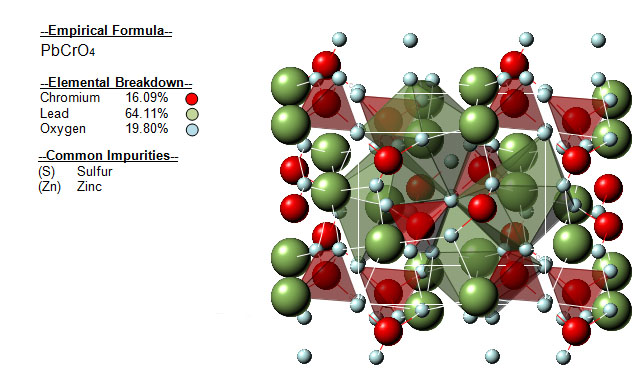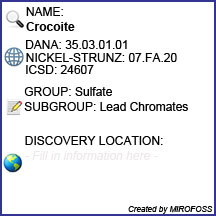

| Mineral Name | Crocoite |
| First Discovered | 1832 |
| Nickel-Strunz Classification | 07.FA.20 |
| Dana Classification | 35.03.01.01 |
| ICSD | 24607 |
| Mineral Group | Sulfates |

| Cleavage | Distinct to indistinct |
| Colour(s) | Yellow, Orange, Red, Red orange |
| Specific Gravity | 6.00 |
| Diaphaneity | Translucent |
| Fracture | Sectile |
| Mohs Hardness | 2.5 to 3.0 |
| Luminescence | Non-fluorescent |
| Lustre | Adamantine |
| Streak | Yellowish orange |
| Habit(s) | Acicular to Sectile to Crystalline |
| Radioactivity | Non-radioactive |
| Magnetism | Non-magnetic |

The following health hazards should be noted when handling crocoite
 |
BIOHAZARD Chromate minerals contain the carcinogenic and mutagenic chromate ion. |
 |
ENVIORNMENTAL HAZARD Chromate minerals can cause harm to the local ecosystem if poured into the water supply. |

The following image shows the Elemental breakdown of the mineral crocoite along with the mineral crystal structure.


| Crystal System | Monoclinic |  |
| Class | Prismatic | |
| Axial Ratios | a : b : c = 0.9569 : 1 : 0.9139 | |
| Optical Data Type | Biaxial (+) | |
| RL Values | nα = 2.290(2) nβ = 2.360(2) nγ = 2.660(2) | |
| 2V | Measured: 57° , Calculated: 54° |  |
| Max Birefringence | δ = 0.370 (See colour chart at right) | |
| Surface Relief | Very high | |
| Dispersion | Very strong r > v inclined | |

Crocoite can be referenced in certain current and historical texts under the following nine names:
Other than in the basic mineral form, crocoite cannot be found in any other distinct variety
The mineral crocoite can be translated into the following select languages:
| Arabic | Bulgarian | Chinese (Sim) | 铬铅矿 | ||
| Croatian | Czech | Krokoit | Danish | krokoit | |
| Dutch | Crociet | Esperanto | Estonian | ||
| Finnish | French | Crocoïte | German | Krokoit | |
| Greek | Hebrew | Hungarian | |||
| Italian | Japanese | 紅鉛鉱 | Korean | 안하이드리트 |
|
| Latin | Minera plumbi rubra | Lithuanian | Norwegian | ||
| Persian | کروکوئیت | Polish | Portuguese | ||
| Romanian | Russian | Крокоит | Slovak | Krokoit | |
| Spanish | Crocoita | Swedish | Tagalog | ||
| Turkish | Krokoyit | Ukrainian | Крокоитом | Vietnamese | crocoit |

Crocite can be found in very few places around the world. The map below shows major documented concentrations of crocoite


 |
The MIROFOSS database offers free printable geological identification tags for personal and non-profit use. These tags can be used to properly identify mineral samples in your collection. -Click here- to download a full size jpeg image for a crocoite identification tag; which can be printed on paper or used with a plastic laser printer. |
 |
What's this? What can I do with it? |

| Chemical Composition | Larsen, E.S. (1921) The Microscopic Determination of the Nonopaque Minerals, First edition, USGS Bulletin 679: 63. |
| Crystallography | Brooke, H.J. and Miller, W.H. (1852) Introduction to Mineralogy by Wm. Phillips, London, 1823. New edition by Brooke and Miller. 8vo, London: 557 (as Lehmannite). |
| History | Palache, C., Berman, H., & Frondel, C. (1951), The System of Mineralogy of James Dwight Dana and Edward Salisbury Dana, Yale University 1837-1892, Volume II. John Wiley and Sons, Inc., New York, 7th edition, revised and enlarged, 1124 pp.:646-649. |
| History | Anthony, J.W., Bideaux, R.A., Bladh, K.W., and Nichols, M.C. (2003) Handbook of Mineralogy, Volume V. Borates, Carbonates, Sulfates. Mineral Data Publishing, Tucson, AZ, 813pp.: 167. |
| Geographical Data | Mindat.org. Retrieved on 2012-05-17 |
| Physical Identification | Webmineral.com. Retrieved on 2012-05-17. |
| May 17, 2012 | The last time this page was updated |
| ©2017 MIROFOSS™ Foundation | |
 |